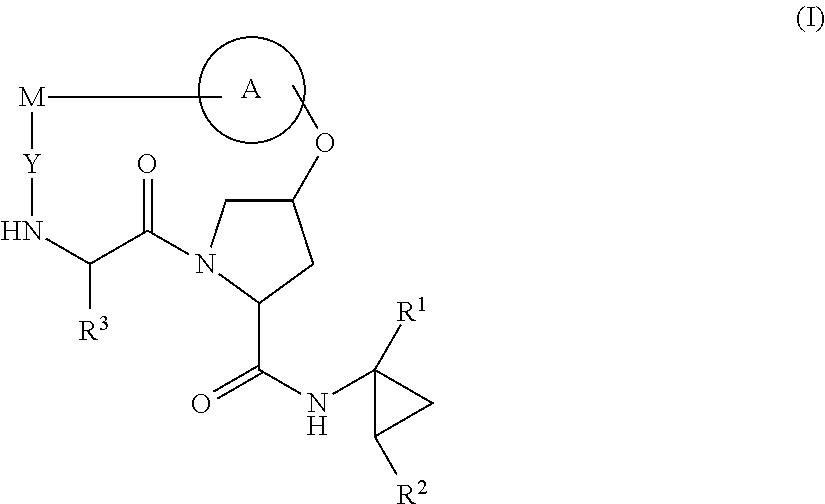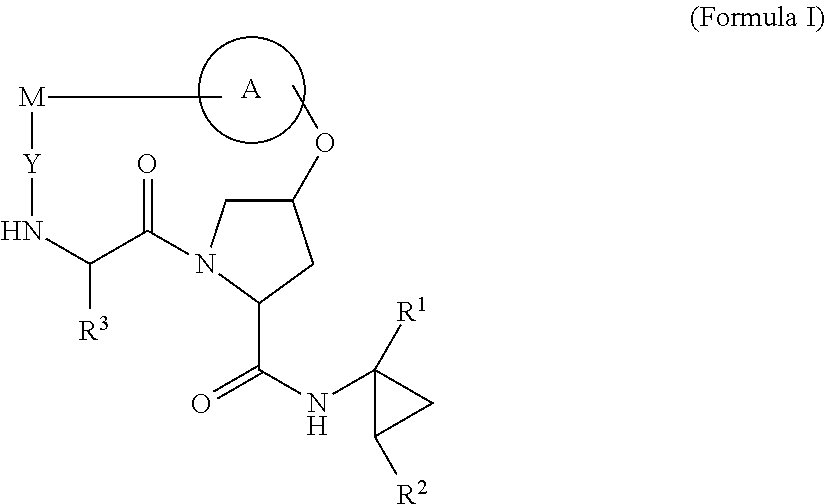HCV NS3 protease inhibitors
a protease inhibitor and hcv technology, applied in the field of macrocyclic compounds, can solve the problems of limited clinical benefit and no established hcv vaccine, and achieve the effect of reducing the likelihood or severity of one or more symptoms
- Summary
- Abstract
- Description
- Claims
- Application Information
AI Technical Summary
Benefits of technology
Problems solved by technology
Method used
Image
Examples
example 1
(3aR,7S,10S,12R,23E,25aS)-7-cyclopentyl-N-((1R,2S)-1-{[(cyclopropylsulfonyl)amino]carbonyl}-2-vinylcyclopropyl)-5,8,19-trioxo-1,2,3,3a,5,6,7,8,11,12,21,22,25,25a-tetradecahydro-10H,19H-9,12-methanocyclopenta[18,19][1,10,3,6,12]dioxatiazacyclononadecino[12,11-b]isoquinoline-10-carboxamide
[0202]
Step 1: 1-tert-Butyl 2-methyl (2S,4R)-4-[(2-but-3-en-1-yl-1-oxo-1,2-dihydroisoquinolin-3-yl)oxy]pyrrolidine-1,2-dicarboxylate
[0203]
[0204]Cs2CO3 (1.1 g, 3.39 mmol) was added to a solution of 2-but-3-en-1-ylisoquinoline-1,3(2H,4H)-dione (0.49 g, 2.26 mmol) and 1-t-butyl 2-methyl (2S,4S)-4-{[(4-bromophenyl)sulfonyl]oxy}pyrrolidine-1,2-dicarboxylate (1.05 g, 2.26 mmol) in NMP (10 mL), and the reaction mixture was stirred for 16 hours at 40° C. An additional portion of 1-t-butyl 2-methyl (2S,4S)-4-{[(4-bromophenyl)sulfonyl]oxy}pyrrolidine-1,2-dicarboxylate (1.0 g, 2.16 mmol) was added, and the reaction mixture was stirred at 40° C. for 16 hours. The reaction mixture was cooled and poured onto a mixt...
example 13
(3aR,7S,10S,12R,25aR)-7-cyclopentyl-N-((1R,2S)-1-{[(cyclopropylsulfonyl)amino]carbonyl}-2-vinylcyclopropyl)-5,8,19-trioxo-1,2,3,3a,5,6,7,8,11,12,21,22,23,24,25,25a-hexadecahydro-10H,19H-9,12-methanocyclopenta[18,19][1,10,3,6,12]dioxatriazacyclotionadecino[12,11-b]isoquinoline-10-carboxamide
[0216]
Step 1: Methyl (3aR,7S,10S,12R,25aR)-7-cyclopentyl-5,8,19-trioxo-1,2,3,3a,5,6,7,8,11,12,21,22,23,24,25,25a-hexadecahydro-10H,19H-9,12-methanocyclopenta[18,19][1,10,3,6,12]dioxatriazacyclononadecino[12,11-b]isoquinoline-10-carboxylate
[0217]
[0218]Pd / C (21.58 mg, 0.020 mmol) was added to a solution of the product from Example 1, Step 4 (80 mg, 0.135 mmol) in THF (4 ml) and stirred under a hydrogen atmosphere for 16 hours. The reaction was filtered through a syringe filter and the organics were removed under reduced pressure. The resulting residue was purified by column chromatography (gradient elution, 20-45% EtOAc / hexanes) to yield the title compound as a gray foam (66 mg, 82%). LCMS (ES+) m / z...
example 37
(3aR,7S,10S,12R,25aR)-7-cyclopentyl-N-((1R,2S)-1-{[(cyclopropylsulfonyl)amino]carbonyl}-2-vinylcyclopropyl)-5,8,19-trioxo-1,2,3,3a,5,6,7,8,11,12,21,21a,22,22a,23,24,25,25a-octadecahydro-10H,19H-9,12-methanocyclopenta[19,20]cyclopropa[14,15][1,10,3,6,12]dioxatriazacycloicosino[12,11-b]isoquinoline-10-carboxamide
[0224]
Step 1: Methyl (3aR,7S,10S,12R,22E,26aR)-7-cyclopentyl-5,8,19-trioxo-2,3,3a,5,6,7,8,11,12,21,24,25,26,26a-tetradecahydro-1H,10H,19H-9,12-methanocyclopenta[19,20][1,10,3,6,12]dioxatriazacycloicosino[12,11-b]isoquinoline-10-carboxylate
[0225]
[0226]The title compound was prepared utilizing a similar procedure for Example 1 utilizing Intermediates C5 and B1. LCMS (ES+) m / z 606.2 (M+H)+.
Step 2: Methyl (3aR,7S,10S,12R,25aR)-7-cyclopentyl-5,8,19-trioxo-1,2,3,3a,5,6,7,8,11,12,21,21a,22,22a,23,24,25,25a-octadecahydro-10H,19H-9,12-methanocyclopenta[19,20]cyclopropa[14,15][1,10,3,6,12]dioxatriazacycloicosino[12,11-b]isoquinoline-10-carboxylate
[0227]
[0228]PdOAc2 (6.67 mg, 0.030 mmol)...
PUM
| Property | Measurement | Unit |
|---|---|---|
| pH | aaaaa | aaaaa |
| volume | aaaaa | aaaaa |
| temperature | aaaaa | aaaaa |
Abstract
Description
Claims
Application Information
 Login to View More
Login to View More - R&D
- Intellectual Property
- Life Sciences
- Materials
- Tech Scout
- Unparalleled Data Quality
- Higher Quality Content
- 60% Fewer Hallucinations
Browse by: Latest US Patents, China's latest patents, Technical Efficacy Thesaurus, Application Domain, Technology Topic, Popular Technical Reports.
© 2025 PatSnap. All rights reserved.Legal|Privacy policy|Modern Slavery Act Transparency Statement|Sitemap|About US| Contact US: help@patsnap.com



